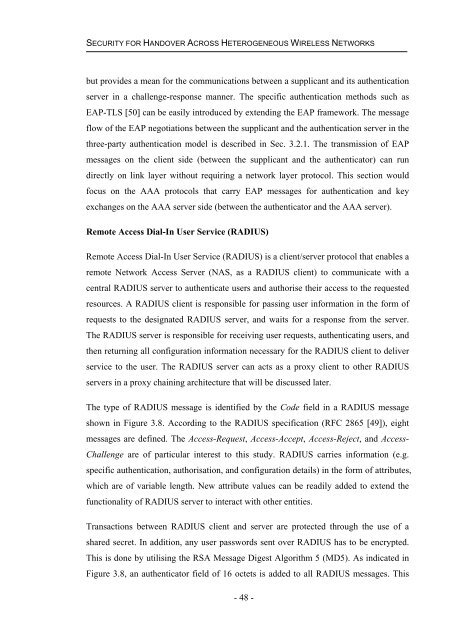Handover mechanisms in next generation heterogeneous wireless ...
Handover mechanisms in next generation heterogeneous wireless ...
Handover mechanisms in next generation heterogeneous wireless ...
You also want an ePaper? Increase the reach of your titles
YUMPU automatically turns print PDFs into web optimized ePapers that Google loves.
SECURITY FOR HANDOVER ACROSS HETEROGENEOUS WIRELESS NETWORKS<br />
but provides a mean for the communications between a supplicant and its authentication<br />
server <strong>in</strong> a challenge-response manner. The specific authentication methods such as<br />
EAP-TLS [50] can be easily <strong>in</strong>troduced by extend<strong>in</strong>g the EAP framework. The message<br />
flow of the EAP negotiations between the supplicant and the authentication server <strong>in</strong> the<br />
three-party authentication model is described <strong>in</strong> Sec. 3.2.1. The transmission of EAP<br />
messages on the client side (between the supplicant and the authenticator) can run<br />
directly on l<strong>in</strong>k layer without requir<strong>in</strong>g a network layer protocol. This section would<br />
focus on the AAA protocols that carry EAP messages for authentication and key<br />
exchanges on the AAA server side (between the authenticator and the AAA server).<br />
Remote Access Dial-In User Service (RADIUS)<br />
Remote Access Dial-In User Service (RADIUS) is a client/server protocol that enables a<br />
remote Network Access Server (NAS, as a RADIUS client) to communicate with a<br />
central RADIUS server to authenticate users and authorise their access to the requested<br />
resources. A RADIUS client is responsible for pass<strong>in</strong>g user <strong>in</strong>formation <strong>in</strong> the form of<br />
requests to the designated RADIUS server, and waits for a response from the server.<br />
The RADIUS server is responsible for receiv<strong>in</strong>g user requests, authenticat<strong>in</strong>g users, and<br />
then return<strong>in</strong>g all configuration <strong>in</strong>formation necessary for the RADIUS client to deliver<br />
service to the user. The RADIUS server can acts as a proxy client to other RADIUS<br />
servers <strong>in</strong> a proxy cha<strong>in</strong><strong>in</strong>g architecture that will be discussed later.<br />
The type of RADIUS message is identified by the Code field <strong>in</strong> a RADIUS message<br />
shown <strong>in</strong> Figure 3.8. Accord<strong>in</strong>g to the RADIUS specification (RFC 2865 [49]), eight<br />
messages are def<strong>in</strong>ed. The Access-Request, Access-Accept, Access-Reject, and Access-<br />
Challenge are of particular <strong>in</strong>terest to this study. RADIUS carries <strong>in</strong>formation (e.g.<br />
specific authentication, authorisation, and configuration details) <strong>in</strong> the form of attributes,<br />
which are of variable length. New attribute values can be readily added to extend the<br />
functionality of RADIUS server to <strong>in</strong>teract with other entities.<br />
Transactions between RADIUS client and server are protected through the use of a<br />
shared secret. In addition, any user passwords sent over RADIUS has to be encrypted.<br />
This is done by utilis<strong>in</strong>g the RSA Message Digest Algorithm 5 (MD5). As <strong>in</strong>dicated <strong>in</strong><br />
Figure 3.8, an authenticator field of 16 octets is added to all RADIUS messages. This<br />
- 48 -












